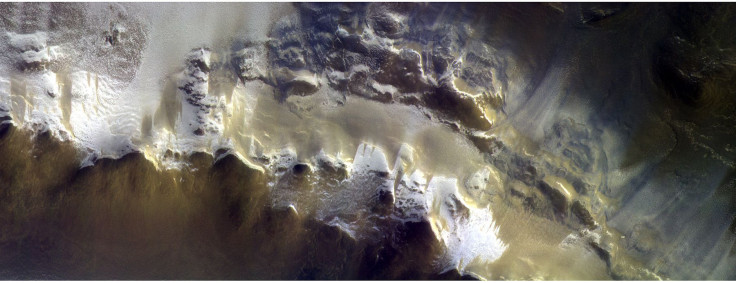ESA’s ExoMars Orbiter Captures Mars’ Icy Crater In Stunning Image

Back in 2016, Russia and European Space Agency’s ExoMars Trace Gas Orbiter (TGO) entered Martian orbit and started beaming crucial scientific data and imagery back to Earth. The spacecraft has improved our understanding of the Red Planet, but just recently, it gave us an amazing colored-shot to cherish — one showcasing a massive crater on the planet’s surface.
The high-res image, taken by the orbiter’s CaSSIS or Color and Stereo Surface Imaging System, gives an unprecedented view of a crater called Korolev. It is located high in the Northern Hemisphere of the planet and is filled with ice.
Viewers can see the 40-kilometer-long segment of the crater in the image. The portion highlighted in bright hue indicates the presence of ice on the rim of depression, which is actually way larger than what has been pictured, according to a release from the investigators of the CaSSIS camera system. In all, the Martian crater spans nearly 85 kilometers in diameter.
That said, it is also worth noting that this — a composite produced from three different images taken almost at the same time — is one of the first colored shots to have been captured by the sophisticated imaging system. The spacecraft entered a new orbit — 400 kilometers above the planet’s surface — a few weeks back and started capturing images as part of a critical testing phase aimed at preparing the system for its main mission.
“We were really pleased to see how good this picture was given the lighting conditions,” Antoine Pommerol, a member of the CaSSIS science team working on the calibration of the data, said in a statement. “It shows that CaSSIS can make a major contribution to studies of the carbon dioxide and water cycles on Mars.”
Though the orbiter’s main mission is to identify and catalog gases indicating active biological or geological activity, the camera system will play a critical role in identifying and capturing the surface features related to the gases. “We are excited to finally be starting collecting data at Mars with this phenomenal spacecraft,” Håkan Svedhem, ESA’s TGO project scientist, said in the same statement. “The test images we have seen so far certainly set the bar high.”
© Copyright IBTimes 2024. All rights reserved.











